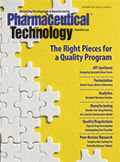Breaking the Drug Shortage Cycle
FDA report says drug shortages are underappreciated and patients pay a price.
In announcing a new report on drug shortages, FDA noted “their [drug shortages] impact is likely underappreciated” (1). The seriousness of shortages of crucial drugs is not lost on doctors, caregivers, and patients.
For example, the ongoing heparin shortage has caused surgeons to reconsider heart surgeries and implement emergency plans. Drugs for childhood cancers, palliative care, septic shock, anesthesia, and sedation are also experiencing shortages. In addition, ongoing shortages are not being resolved. In fact, after declining from a peak in 2011, the number of ongoing drug shortages has increased, with some shortages continuing for eight years.
While production- and quality-related issues have previously been cited as the reasons specific drugs may experience shortages, the report had a direct assessment of the root cause: economic factors are the cause of drug shortages.
Under the direction of Congress, FDA in July 2018 established an Agency Drug Shortages Task Force, which was charged with identifying the root causes of drug shortages and suggesting potential long-term solutions. The task force included representatives from FDA, the Centers for Medicare & Medicaid Services, and other federal agencies impacted by drug shortages.
The resulting report “Drug Shortages: Root Causes and Potential Solutions” (2), published in October 2019, was based on FDA analysis of data on 163 drugs that went into shortage from 2013 to 2017, as well as comparisons to similar drugs that were not in short supply. The report also considered published research, comments at public meetings, and input from representatives from the public and private sectors. Not surprisingly, drugs that are relatively low in price, “financially unattractive” drugs, and sterile injectables are more likely to be in short supply.
The task force’s report identified an unusual business pattern that does not follow “textbook” practices during a product shortage. After a typical shortage, the report said, prices go up and other suppliers are incentivized to enter the market. With drug shortages, this scenario does not occur.
Instead, “prices rarely rose after shortages began, and during shortages, production typically did not increase enough to restore supply to pre-shortage levels. Many manufacturers reported discontinuing the production of drugs before a shortage for commercial reasons (e.g., loss of profitability),” FDA reported in a statement announcing the report. “These results suggest a broken marketplace, where scarcity of drugs in shortage or at risk for shortage does not result in the price increases predicted by basic economic principles,” the statement continued.
Three root causes identified are a lack of incentives for manufacturers to produce less profitable drugs; no recognition for manufacturers that have mature quality systems that focus on continuous improvement and early detection of supply chain issues; and logistical and regulatory challenges make it difficult to recover from a disruption.
The task force suggested a shared understanding of the impact of drug shortages be created, including quantifying the harms of shortages, developing a quantitative characterization of the shortage, and more transparent pricing from contract manufacturers. Development of a rating system to encourage drug manufacturers to invest in quality management maturity for their facilities, and the promotion of sustainable private sector contracts to make sure there is a reliable supply of important drugs were also suggested.
References
1. FDA, “Statement on FDA’s New Report Regarding Root Causes and Potential Solutions to Drug Shortages,” Oct. 29, 2019.
2. FDA, “Drug Shortages: Root Causes and Potential Solutions,” Report, October 2019.
Article Details
Pharmaceutical Technology
Vol. 43, No. 11
November 2019
Page: 10
Citation
When referring to this article, please cite it as R. Peters, “Breaking the Drug Shortage Cycle," Pharmaceutical Technology 43 (11) 2019.

Drug Solutions Podcast: A Closer Look at mRNA in Oncology and Vaccines
April 30th 2024In this episode fo the Drug Solutions Podcast, etherna’s vice-president of Technology and Innovation, Stefaan De Koker, discusses the merits and challenges of using mRNA as the foundation for therapeutics in oncology as well as for vaccines.
Drug Solutions Podcast: Gliding Through the Ins and Outs of the Pharma Supply Chain
November 14th 2023In this episode of the Drug Solutions podcast, Jill Murphy, former editor, speaks with Bourji Mourad, partnership director at ThermoSafe, about the supply chain in the pharmaceutical industry, specifically related to packaging, pharma air freight, and the pressure on suppliers with post-COVID-19 changes on delivery.